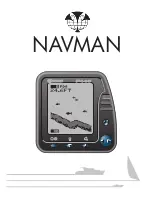
16
NAVMAN Fishfinder User Manual
Alarms
There are three different types of alarms, Fish,
Shallow, and Deep. All the alarms activate the
internal buzzer if their alarm condition is met.
The buzzer will provide three different alarm
signals. A short alarm signal for a mid water
echo, such as a fish, a long continuous signal
for a shallow water alarm and a series of short
signals for a deep alarm. Each alarm can be
individually enabled or disabled. All enabled
alarms can be simultaneously disabled with a
single key press.
The alarm indicator bar on the top left of the
display shows which alarms have been selected.
They are fish ‘F’, shallow ‘S’, and deep ‘D’.
Fish Alarm Alerts you with a single short signal
when an object that could be a fish is detected.
The alarm for a small fish is shorter than the
alarm for a bigger fish.
Shallow Alarm Alerts you when the water
depth is shallower than the shallow alarm setting,
i.e., the water becomes too shallow.
Deep Alarm Alerts you when the water depth
is deeper the deep alarm setting, i.e., the water
becomes to deep.
Alarms on the FISH440
When either or all of the Fish, Shallow or Deep
alarms are active they are displayed on the
screen. When an alarm is triggered there is a
beep and the corresponding alarm’s figure
flashes on and off.
Anchor Drag Alarm
The Shallow and Deep Alarms can be set just
above and below your anchored depth. An alarm
will sound if your anchor drags and you drift into
deeper or shallower water.
Be sure to disable the fish alarms in this mode to
prevent false anchor drag alarms due to fish.
Setting the alarms
•
Press the
∗
key until the alarms menu is
displayed
•
Press either the
key or the
key to
move the pointer to the required alarm
•
Use the
V
or the
^
key to adjust the
alarm setting to the desired depth level.
OFF is shown if shallow alarm value is 0 or
deep alarm value of 600 feet is selected
•
Press the
key to accept the choice
and return to normal display mode
Summary of Contents for FISH 440
Page 1: ...NAVMAN F440 NAVMAN...
















